Animal symbolism in Chinese art 兽 shòu

Animals are traditionally classified into five groups: scaled animals are led by the dragon, naked creatures by man, furry animals by the unicorn, feathered birds by the phoenix and shelled creatures by the turtle. In the theory of five elements of nature each of the five classes of animals are associated with a compass direction dragon: east; phoenix: south; unicorn: west; turtle: north and humans: center.
Another set of five animals are the five noxious creatures: snake, centipede, scorpion (or spider), gecko (or lizard) and toad. Here are some animals that are noted for their symbolism in Chinese art:
Ant 蚂蚁 mǎ yǐ
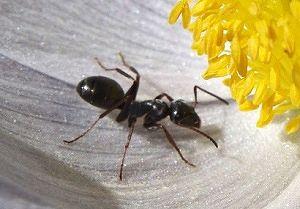
Ants are hard-working and well-ordered. The second part of the name (yi) means righteous, denoting its apparent display of Confucian virtue which sounds the same as义 (old form 義) yǐ ‘respectful manner’.
The black ant is considered useful as it attacks the dreaded white ant (termite) 白蚁 bái yǐ which eats away at anything wooden. Although hard-working it is considered self-interested and so is sometimes used proverbially for selfishness. The ant is rarely portrayed symbolically in works of art.
Ao 鳌 áo
The giant turtle (or sometimes fish) ‘Ao’ features in some creation myths. In China there was a belief that the whole Earth was on the back of a giant turtle. There is a long association with turtles acting as stabilizing creatures as they are so firmly rooted to the ground. They are thought to eat fire and so may feature as a figure on the end of a roof ridge to help keep fire away.
The Ao, as a giant fish has been associated with examinations, there is a legend that the ‘Ao’ will appear in dreams before passing exams. The three top candidates were proclaimed on the ‘ao tou’ noticeboard and so pictures wishing good luck in exams may feature a turtle or fish. A legend has it that Kuixing, the god of examinations was rescued from suicide by a sea turtle. The Ao shan (mountain) was considered to lie in the ‘Isles of the Blessed’ to the East of China.
Badger 獾 huān
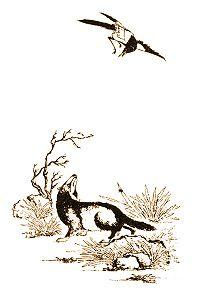
Badgers in a picture symbolize happiness because 獾 huān sounds just the same as 欢 huān ‘joyous, happy, pleased’, badgers are almost always portrayed with magpies as they also give the wish for happiness. In some regions cats and badgers were given the same name so a picture of a cat may actually signify ‘happiness’. A flying magpie and a badger represent happiness both in heaven (sky) and on earth; while if the magpie is perched they represent a wish for future happiness.
Bat 蝠 fú
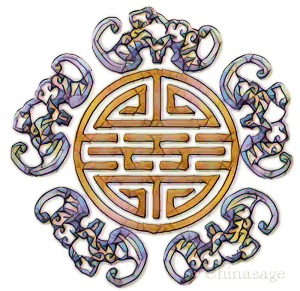
The Chinese have long known that bats are flying rodents. They are also known as 天鼠 tiānshǔ ‘sky rat’ and 附翼 fùyì ‘embracing wings’. Bats are welcome arrivals because they eat huge numbers of flying insect pests. As they hibernate in caves there are legends about white bats that live for a thousand years and their body parts have been used in traditional medicine potions for longevity.
Their symbolic importance comes from a linguistic coincidence; the character for bat 蝠 fú sounds the same and looks similar to 福 fú ‘good fortune’ and so bats are commonly seen as decorations on ornaments and as motifs in paintings to wish good luck. Two bats symbolize double happiness. The five blessings of life (health, wealth, virtue, long life, peaceful death) are often represented by five bats sometimes surrounding the 寿 shòu emblem for longevity. The Rúyì 如意 is a good luck charm that can be drawn in a shape like a bat's wings. There are many other combinations that have particular meanings, a red bat, for example, is a wish for great happiness, a bat with peaches a wish for a long and happy life, five bats and a box is a wish for a harmonious life of five blessings.
Bear 熊 xióng
The bear is strong and brave and so symbolizes these qualities in art-work - the masculine side. If a pregnant woman dreams of a bear she is supposed to give birth to a son. Although the panda is the best known bear in China historically it was the black and grizzly bears that used to widely roam through most of China over the centuries. Many parts of a bear have been used in traditional medicine particularly the bile and bear paws were also eaten as a delicacy. A bear is considered a good talisman against robbers. In ancient times, up to the Han dynasty, when they were more numerous and so were used frequently as motifs in old artwork.
Bee 蜜蜂 mì fēng

Bees are not often found in paintings but if they appear they represent, when combined with a monkey (猴 hóu), an aspiration to high office as 封 fēng means ‘bestow high office’ and 侯 hóu ‘a marquis ➚’. Because bees bring about pollination they represent the male gender and so if bees are shown with peony flowers this shows a young man seeking love.
The character for bee is composed of the insect radical with the character for an awl ➚ to represent its sharp sting. The wild Chinese bee is smaller and less ferocious than other bee species. The art of honey bee-keeping was considered a hobby and honey was a luxury food. Chinese traditional bee hives were hour-glass shaped with a narrow central opening just large enough to let one bee through.
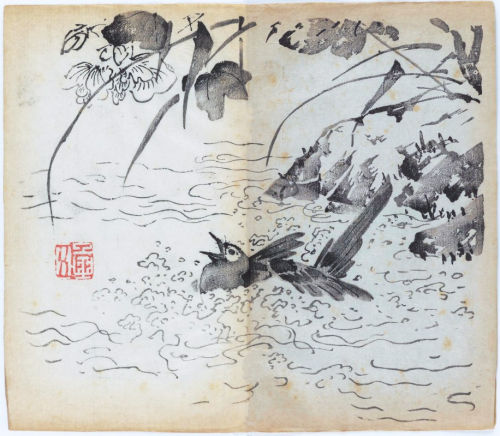
Bird 鸟 niǎo
For all about phoenixes, pheasants, parrots, doves and many other birds please see our section full of birds.
Butterfly 蝴蝶 hú dié

Butterflies as things of beauty and summer warmth are often found in Chinese paintings. Sometimes a butterfly seeking flowers symbolizes a young man's quest for love. In particular a butterfly and plum blossom mean a quest for blissful love. A mandarin duck and a butterfly together signifies unrequited young love. A homophone is 叠 dié which means ‘to repeat’, so adding a butterfly to a scene repeats the wish of the other symbols.
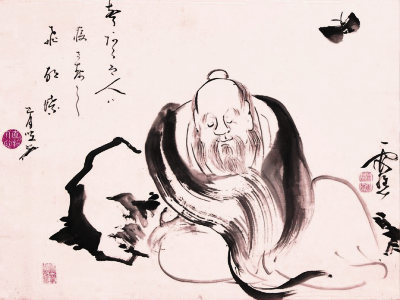
Because 耋 dié ‘elderly, over eighty’ sounds the same, it can also symbolize a wish for long life. This symbolism is re-enforced by a cat: 耄 mào because 耄耋 mào dié means ‘venerable’.
The most famous Chinese butterfly is the one in the vision of the Daoist philosopher Zhuangzi. Was he dreaming of life as a butterfly or a butterfly dreaming of life as a man? A different story about this incident has him, less poetically, chasing a butterfly and stumbling into the grounds of a house where he sees a lovely young lady with whom he falls in love.
Carp 鲤鱼 lǐ yú
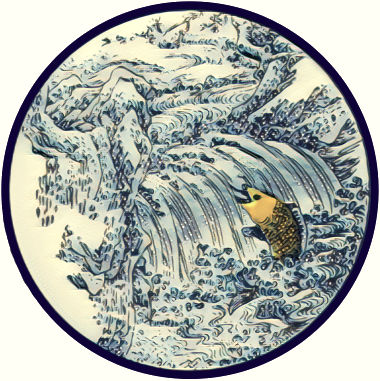
A carp symbolizes a good wish as it sounds similar to 利 lì ‘favorable, benefit, advantage’ and 力 lì means ‘strength, power’. As the fish lays many eggs it also conveys the wish for many children. It has long been associated with wishing success in the state examinations. If a candidate was successful at the exams at Beijing he could buy a boat trip back home from the travel agents on nearby ‘Carp Street’ 鲤鱼胡同 lǐ yú hú tòng. Carp swim hard and leap up the currents in the Yellow River at the Dragon Gate ➚ rapids, Shaanxi and so it is associated with endeavor and determination. According to legend ‘Dragon Gate’ (龙门 Lóngmén is where a carp was transformed into a dragon and that took on the meaning of passing the examinations and becoming a powerful and rich government official: 鲤鱼跳龙门 Lǐ yú tiào lóng mén ‘may you gain quick success’.
Wang Xiang (王祥) is an example of filial piety, he was unable to buy carp as medicine for his sick father and his evil step-mother, so he sat and wept on a frozen river for so long that his tears melted a hole in the ice through which two carp sprang out into his hands.
The goldfish (a kind of carp) 金鱼 jīn yú is a symbol for ‘an abundance of wealth (gold)’ often shown with a lotus (金玉同合 jīn yù tóng hé a wish for gold and jade). In the Ming dynasty delicately carved and multi-colored Imperial fish bowls 五彩 wǔ cǎi became the height of fashion.
Cat 猫 māo
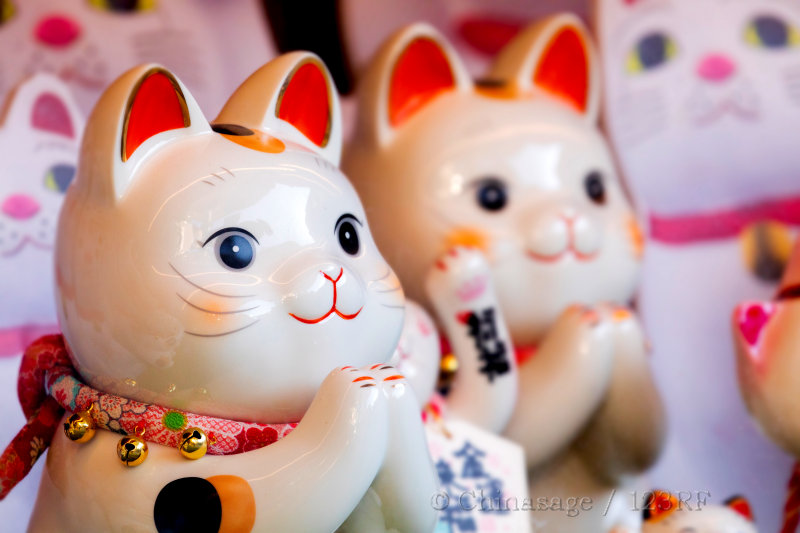
With so many cute and cuddly cats on the Internet it is surprising that cats generally have a poor traditional image in China. It should be remembered that cats were kept for controlling pests rather than pets. They were particularly important for controlling the rats that ate the silkworms and hence another name ‘silkworm cats’ 蚕猫 cán māo. The character for cat shows an animal and a field of grain, suggesting its role as vermin catcher.
As in western culture a cat has some more sinister associations. It can see spirits in the dark and should be cremated and not buried as otherwise it could turn into a demon. The arrival of a strange cat to a house bodes ill as the cat can sense that misfortune is about to fall and the house will become dilapidated and become home to rats and mice. The cat only appeared as domesticated animal about 2,500 years and does not appear in ancient legends or included in the astrological zodiac of 12 animals.
The similar sounding mào耄 means someone in 80s or 90s so a picture of a cat may symbolize a wish for long life.
One of the most commonly seen sculptures are 'lucky cats' which commemorate the story of a cat that helped a Japanese shopkeeper in a time of poverty by beckoning customers to come and visit his store.
Centipede 蜈蚣 wú gōng

The centipede is one of the five noxious creatures and as such is associated with powerful magic potions. It is considered the enemy of the snake but is readily eaten by hens. The Dragon Boat festival (mid summer) was a time to brush away centipedes from the home.
Cicada 蝉 chán
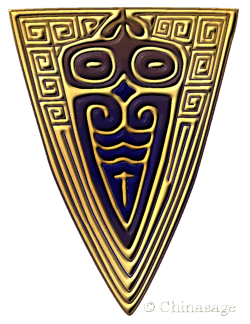
The cicada is a potent symbol of immortality due to its life cycle, they emerge as if by magic out of the ground after many years living unseen as grubs eating roots. The symbol of an idealized cicada denotes a wish for immortality and a jade cicada was placed in the mouth of the deceased in ancient times. They are sometimes known as ‘Maidens of Qi’ after a legend that the Queen of the kingdom of Qi transformed into a cicada. Male cicadas were kept as pets in a small box as they ‘chirp’ noisily to attract females. The keeping of a pet cricket (or cicada) was used as a significant symbol in the film the The Last Emperor about Emperor Puyi.
The closely related insect, the cricket 蟋蟀 xī shuài, was captured and used for a cricket duel between two males; bets were placed on which insect would win. A cricket can therefore symbolize summer and conflict.
Cow
See Ox.
Crab 蟹 xiè
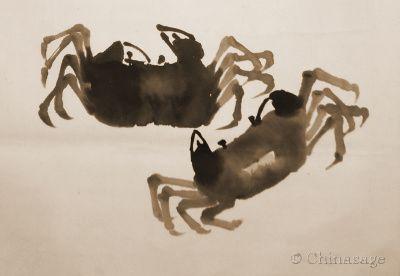
The crab is often used symbolically as the name sounds the same as 燮 xiè ‘harmony, blend in’. There is an ancient legend that some ancient crabs were originally made of jade. Crab meat has long been used as an aphrodisiac. The crab’s protective shell 甲 jiǎ also means ‘first’ - it is the first heavenly stem and so expresses the wish to come first - particularly in examinations. So two crabs among rushes has the rather complex meaning 二甲传胪 èr jiǎ chuán lú a wish for first place in the second class (Ju Ren) of examinations.
Deer 鹿 lù
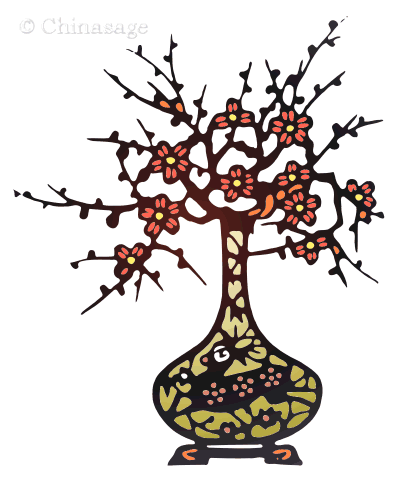
The graceful and beautiful deer is not included in the Chinese zodiac but does feature in paintings. It symbolizes longevity and riches as deer were believed to live to a great age. 禄 Lù means ‘good fortune’ and ‘government salary’ and 璐 lù is also another word for ‘precious jade’. The god of longevity is often shown with deer and it is reputed to be able to locate the herbs of immortality. The character for deer is used within the character 丽 lì ‘beautiful; elegant’ it shows a deer decorated with two pendants, but this is only really evident in the old form of the character 麗. Because of the association with long life ground up stag's antler is used in traditional medicine.
The yak was considered a kind of deer, although it is actually a kind of cow (Bos mutus) and due to its strange features was one of the ‘four dis-similars’ 四不像 sì bù xiàng as it has a stag’s horns, a camel’s body, ox’s feet and an ass’s tail.
There is a popular legend about devotion to parents concerning deer. Zhou Yanzi ➚'s father grew sick and the only cure was deer’s milk, so Zhou Yanzi disguised himself as a deer by covering himself with a deerskin and joined a herd so he could milk a doe. This act makes him one of the 24 examples of devotion to parents often portrayed in paintings and on porcelain.
Dog 狗 gǒu

Dogs get a mixed treatment in China. They have been farmed for meat in the south and for fur in the north and yet the famous Dowager Empress Cixi was devoted to her Pekingese dogs ➚. They are honored by a position in the Chinese zodiac. The Han Emperor Ling 汉灵帝 (168-189CE) is reputed to have become besotted with dogs, elevating one to a high official rank. In northern China paper dogs were thrown into water at the Dragon Boat festival to drive away evil. In this sense a dog accompanies the god Erlang ➚ to drive out demons. This may also explain why dogs were frequently placed at the feet of the dead to guard and keep the deceased company.
The ancient character 犬 quǎn is also used for ‘dog’. It is a common radical used for many animals with four legs. Yellow dogs 黄狗 huáng gǒu are sometimes colloquially called ‘wonks ➚’ in the south. Some of the minority people in southern China were believed to be descended from dogs because of their ferocity. A dog that approaches you with a wagging tail foretells the coming of wealth.
The Pekingese lap dog received high favor because it resembled a miniature Buddhist lion, and they were bred to be as lion-like as possible. In southern China a dog's faithfulness is highly valued. Examples of extreme loyalty of a dog to its master are noted in legends.
Donkey 驴 lǖ
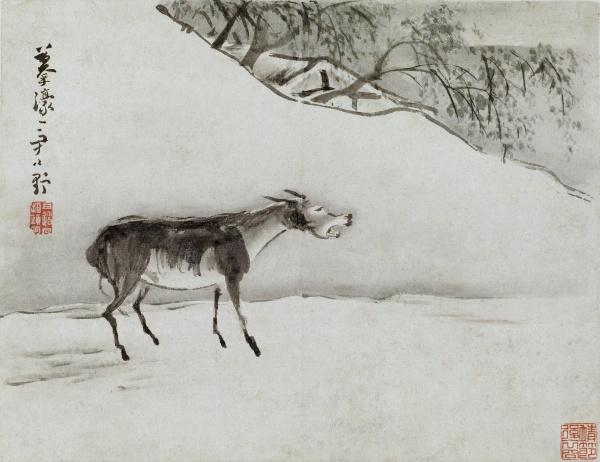
With frequent, widespread famines in China the donkey was at times eaten as well as used as a beast of burden. Donkeys were a common sight in northern and central China busy plowing the fields or carrying heavy goods. Unlike its close relative the horse it is not in the Chinese astrological zodiac or ancient texts; this suggests it came quite late to China, probably in the Han dynasty. It is associated with poor people and ascetic hermits and so it represents steadfastness and determination. Just as in Europe the donkey has an undeserved reputation for stupidity.
One of the eight Daoist Immortals Zhang Guo Lao is often depicted riding a magic donkey which was made of paper so he could fold it up and store it in his bag.
Dragon 龙 lóng
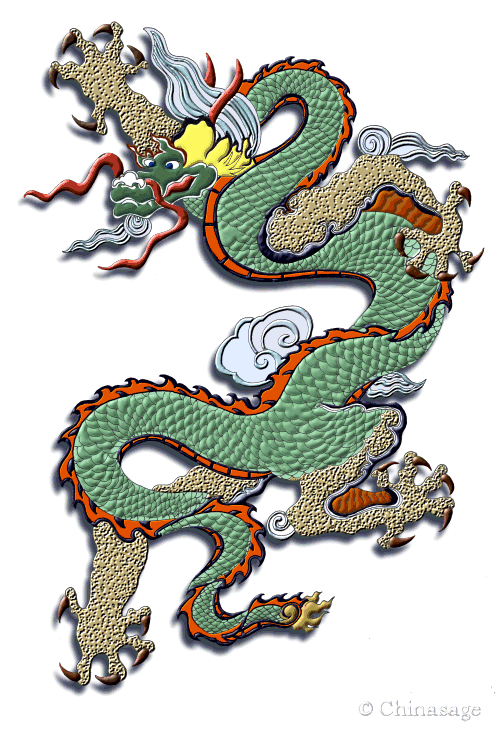
Dragons are so important and pervasive in Chinese culture we have dedicated a whole section to this flying animal. In brief summary, the dragon is the mightiest of creatures, master of rain and water and usually good-natured. It has a prestigious place in the astrological years and serves as a symbol principally of the emperor and therefore the top of the pyramid of animals. When shown with a phoenix it represents emperor and empress - the foremost married couple; with a phoenix the two together represent ‘animals and birds’ and so wildlife in general.
Ancient belief ties the dragon to the bringing of life-giving rain in the form of master of the storm clouds. In appearance it is more serpent-like than the Western version and is usually portrayed among the clouds.
Dragonfly 蜻蜓 qīng tíng

The ferocious and veracious predator of other insects, the dragonfly is considered a useful friend.
It is an emblem of summer as they overwinter in the form of grubs and their short existence in the air symbolizes fleeting moments. As it sounds the same as ‘清 qīng’ it is used to symbolize purity and this makes it a common pairing with the pure, white lotus flower. It was believed in ancient China that the wind gave birth to insects as they seem to come in waves borne by storms. The old form of the character for wind 风 fēng was 風 denoting an insect in the air.
Elephant 象 xiàng
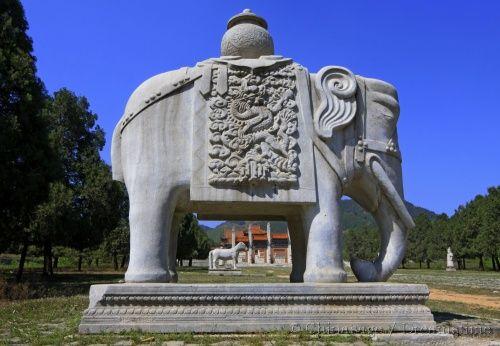
Elephants used to roam throughout most of China but are now restricted to a few mountains in Yunnan.
Tales from ancient times occasionally mention the mighty elephant. The legendary Emperor Shun is portrayed plowing with an elephant and heroes were shown riding one. Marco Polo reported that the Great Khan (Kublai Khan) traveled in a great wooden room built on the backs of four elephants. Stone elephants often stand on the Sacred Ways to tombs. It is associated mainly with Buddhism and an elephant is said to have transported the Buddha to the world.
The Imperial Elephant Stables 象房 xiàngfáng stood near the Xuanwumen Gate in Beijing. Elephants were used in key Imperial ceremonial processions and came from Vietnam and Burma. On the sixth day of the sixth month the keepers took the elephants for a thorough wash in the moat surrounding the city wall.
Chinese Chess is called is called ‘Elephant Game’ in Chinese 象棋 xiàng qí as one of the pieces is called an elephant that moves a bit like a bishop in western chess. Elephant 象 xiàng sounds like 想 xiǎng which means ‘think’ or ‘ponder’ - very appropriate for both the game of chess and the ponderous animal.
A picture showing someone riding on an elephant symbolizes happiness 骑象 qí xiàng as it sounds like 吉祥 jí xiáng ‘auspicious; lucky’; to reinforce the motif, the cloth on the elephant’s back often has the symbols for good fortune. The cloth represents a saddle 鞍 ān that is a homophone for 安 ān ‘contentment; peace’. A vase and an elephant gives the wish for 太平有象 tài píng yǒu xiàng ‘great peace and security will soon appear’ (as vase 瓶 píng sounds the same as ‘peace’).
Ivory (象牙 xiàng yá ‘elephant tooth’) has been used for thousands of years for carved ornaments and the import of African ivory through Hong Kong was for a long time an active but illegal trade. It first came from Indian elephants. When elephants were numerous their trunks was considered a culinary delicacy and their hide was used to bind serious wounds.
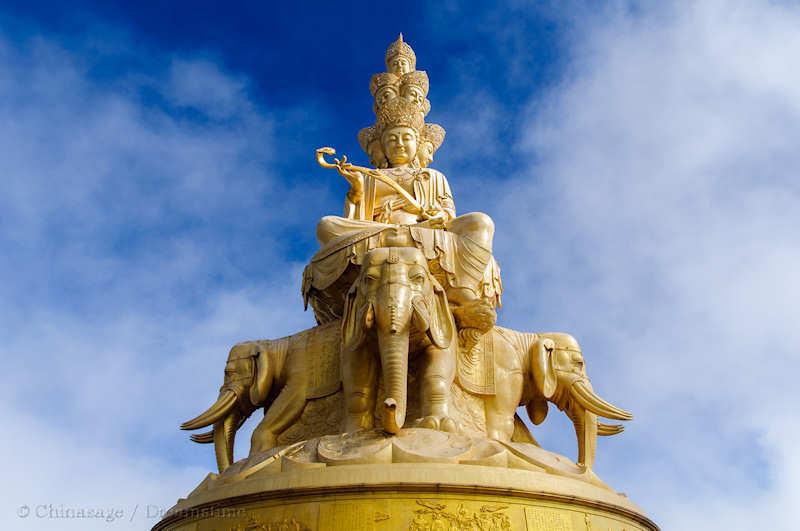
Fish 鱼 yú

Fish symbolize a wish for abundance and affluence, this is one of the best known homophones as 余 yú meaning ‘surplus’ so a child with a fish symbolize a wish for extra children. A goldfish 金鱼 jīn yú is a standard symbol for ‘an abundance of gold’. Chinese people have for a long time kept fish as pets in ponds and bowls.
Fish are a very important part of the ordinary diet of the Chinese, as fish rather than meat often provide the protein. The lower Yangzi river, in particular Jiangsu is known as the ‘land of fish and rice’ with its many lakes and rivers. Fish are often eaten at the Spring Festival (when fresh meat is in short supply) symbolizing a wish for abundance in the year to come. If shown with a lotus blossom it conceals the wish that the surplus should last for years because 莲 lián ‘lotus’ sounds the same as 连 lián ‘successive’.
The carp 鲤 lǐ has its own rich symbolic associations (see separate carp entry). Fish are often shown in pairs, some think this is a metaphor for the shape of the taiji figure, as a pair they are one of the eight treasures, others that is about conjugal bliss. Two fishes with a stone chime give the wish 吉庆有余 jí qìng yǒu yú for ‘good fortune in abundance’. The catfish 鲶鱼 nián yú is prominent at the Spring New Year festival as 年 nián means ‘year’.
There are legends of drunken men turning into fish demons, who could be unmasked because they need to bathe each day. Because fish breed prolifically and are frequently seen in pairs they can symbolize marriage and wish for many children. Fishermen 渔夫 yú fū are a respected profession set above merchants and officials as they provide food. The art of government has been likened to the art of fishing as it requires both patience and careful observation. There is a legend that Emperor Fuxi learned the art of fishing and invented the fish trap.
Fox 狐狸 hú li

While many creatures in the west have a worse reputation than in China for example rats, pigs and dragons for the fox it is the other way around. In the west a fox is admired for its cunning and determination, in China it has a much more evil connotation. It is reputed to live to a great age, when it reaches fifty it can turn itself into a woman, at hundred a seductive girl and at a thousand it becomes a powerful god with nine tails.
The evil consort 妲己 Daji ➚ of the last Emperor of the Zhou dynasty (Emperor Shou) was reputed to have been a metamorphosed fox who acted with great cruelty, devising tortures for innocent people - including roasting them alive in bronze cauldrons.
The association with spirits may originate from the observation that foxes raided graves for the food laid out for the ancestors, and so were thought to be the departing spirit of the deceased. The fox spirit had to be appeased with offerings. Another superstition is that even the writing of the character for a fox is unlucky so the homophone 胡 hú is sometimes written instead.
Frog
See Toad.
Gecko 壁虎 bì hǔ
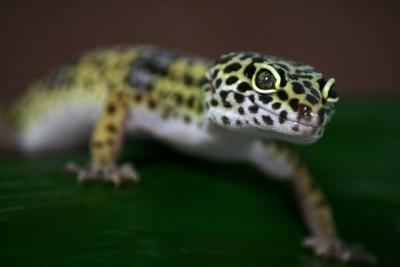
The gecko is a common sight in southern Chinese houses, scampering over the walls and ceilings to catch insects. The name denotes its hunting skill, it means ‘wall tiger’. It is considered one of the five poisonous creatures and so a mixture of all five together was very potent. Another powerful potion was made by feeding a gecko with cinnabar for a year; the pounded remains of the creature were then applied to the skin to both detect and prevent infidelity.
Glow worm 萤火虫 yíng huǒ chóng
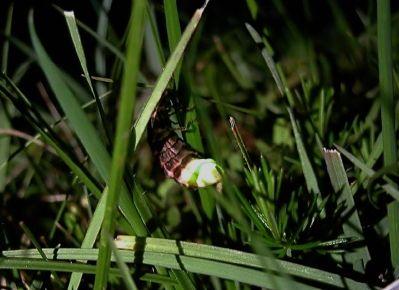
The glow-worm (Lampyris noctiluca) is common across from Europe into Asia, it is the female that gives the bright glow to attract males. Symbolically it stands for beauty, perseverance and loyalty.
In a tale mentioned in the Three Character Classic, 车胤 Chē Yìn was too poor to own a lamp, so in order to study the classics and pass the Imperial examinations he collected many glow-worms so he could see to read at night. He went on to pass the exams and became a senior government official.
Goat
See Sheep.
Hare 兔子 tù zi
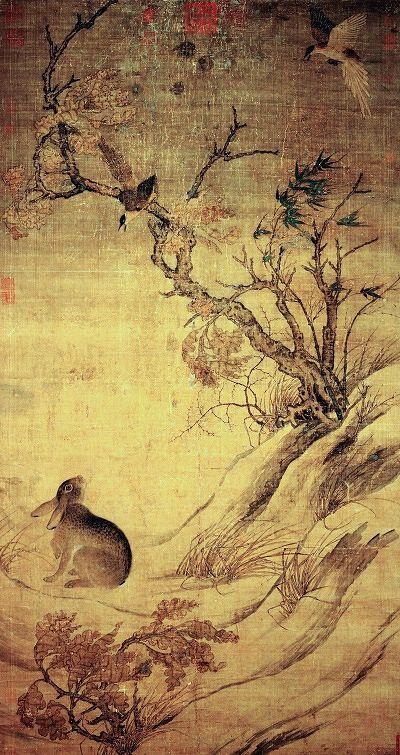
The hare in China is not generally distinguished from its close relative the rabbit, so ‘hare’ and ‘rabbit’ are used interchangeably. The hare has its place in the astrological zodiac of twelve animals. It is associated with the moon, the Jade Rabbit 月兔 Yùtù was the name of the Chinese moon rover that landed in 2013 and Jade Rabbit 2 in 2019. It was thought that the gray shape on the moon looks like a hare where it accompanies the goddess of the moon Chang'e while mixing the elixir of immortality, and this associates the hare with longevity. A man with a hare's head surrounded by six boys represents the Moon Festival (Zhongqiujie 中秋节) at full moon in the eighth month. A red hare is an auspicious animal and appears when rule is virtuous. There are legends that a hare becomes pregnant by gazing at the moon or just licking the fur of the female. As such a rabbit/hare is associated with the wish to have many children.
The character for injustice, oppression 冤 yuān is made up of the character for a hare under a cover, suggesting this wild creature, in particular, does not enjoy incarceration.
Horse 马 mǎ
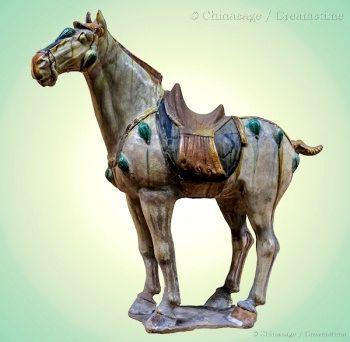
Horses as pasture animals feature more in ancient times when the center of civilization was further north around the Yellow River as horses came from central Asia, Mongolia and Tibet. In the ancient Yi Jing the horse represents ‘yin’ compared to the dragon ‘yang’. The god of war Guan yu (Guan di) rode a red-haired horse. Horses are associated with the element metal and west.
The character 马 mǎ is a pictogram of a rearing horse, which is clearer in its old form as 馬. The legendary 穆王 Mù wáng of the Zhou dynasty is often portrayed in paintings; eight horses drew his chariot with which he toured the provinces in search of the palace of the Queen Mother of the West.
In the Tang and Mongol dynasties - both peoples from the northern pasture lands - horses were greatly admired animals and appear in a wide range of artwork. Horse meat was and is still eaten in China and medicines are made from body parts. One Tang Emperor had a troupe of dancing horses to keep him entertained.
In symbolism a horse laden with goods is a wish for a government post, it may also indicate swiftness. A monkey 猴 hóu on horse back expresses the wish for promotion quickly as 侯 hóu is a noble rank and 马上 mǎ shǎng ‘on horseback’ is a metaphor for ‘arrive quickly’. A picture of an official on horseback under a canopy and accompanied with nine other people, commemorates the legend of Liang Hao (Song dynasty) who passed the Imperial Examinations at the age of 84, a symbol of dogged determination.
Lion 狮 shī
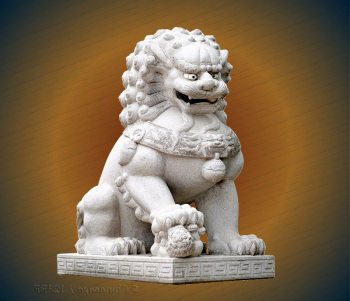
Although the lion has never dwelt in China, it is a common art motif with lion statues guarding the entrances to temples. The character contains the homophone 师 shī which means ‘master’ combined with the ‘animal’ radical.
Although some lions were given to the emperor as tribute from vassal kingdoms, most knowledge of the beast came indirectly so representations are often more like pet dogs than fierce cats. Indeed the Pekingese dog ➚ was selectively bred to look like a Chinese lion. The lion is usually depicted resting on the ground with forefeet pointing outward and is mostly associated with Buddhism. It represents wealth and power and can keep evil at bay. At entrances to temples the lion on the right is male and holds a ball in its paw while the left lion is female and holds a cub. A pair of lions symbolize happiness and wish for a prosperous career. The number of curls of hair on the lion's mane used to be a measure of seniority, a high official would have up to 13 coils of hair on lion statues outside his home. There are 500 stone lions on the famous ‘Marco Polo’ bridge near Beijing each one of which is different. A lion was also the emblem of some grades of official. In pictures, two lions and a ruyi symbolizes a wish for everything to go as desired (事事如意 shì shì rú yì).
Lion dances (狮子舞 shī zi wǔ) often have two lions chasing a ball (毬 qiú) and is similar to two dragons chasing a ball or pearl. The lion dance was traditionally associated with just the Lantern festival but is now seen at other Chinese festivals too. If a dancing lion can be enticed into your home it will bring good luck.
Monkey 猴 hóu
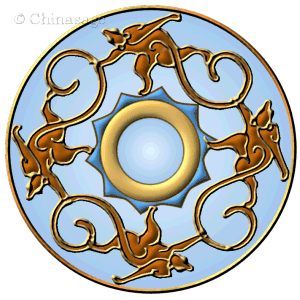
The monkey is seen as a cheeky, irreverent creature in China always bringing fun and laughter. Monkeys live in central and southern China but not in the north. It has a high place in the zodiac of twelve animals. The character for monkey 猴 hóu has a man shooting an arrow at a target, representing a nobleman, adding the ‘dog’ radical turns it into the prince of animals: the monkey. In southern China some minority people were presumed to be the descended from them. Monkeys were considered able to drive away evil spirits and for this reason were worshiped and tolerated near houses. There are records of monkeys being kept as pets a thousand years ago.
The famous Monkey King 孙悟空 Sūn wù kōng features in the ‘Journey to the West’ where he helped Tripitaka bring Buddhist scriptures from India which has been made into numerous films. Legends have the Monkey King cheekily stealing some of the peaches of immortality from the garden of the Queen Mother of the West (Xi wang mu) and so a monkey is often depicted carrying off a peach.
A monkey riding on a horse expresses the wish for quick promotion as 侯 hóu is a noble rank and 马上 mǎ shǎng ‘on horseback’ is a metaphor for ‘arrive quickly’. A bee or wasp 蜂 fēng may be included as to make the phrase 马上封候 mǎ shàng fēng hòu (feng means ‘grant title’). Two monkeys in a pine tree symbolize a wish for promotion to last many generations.
Ox 牛 niú
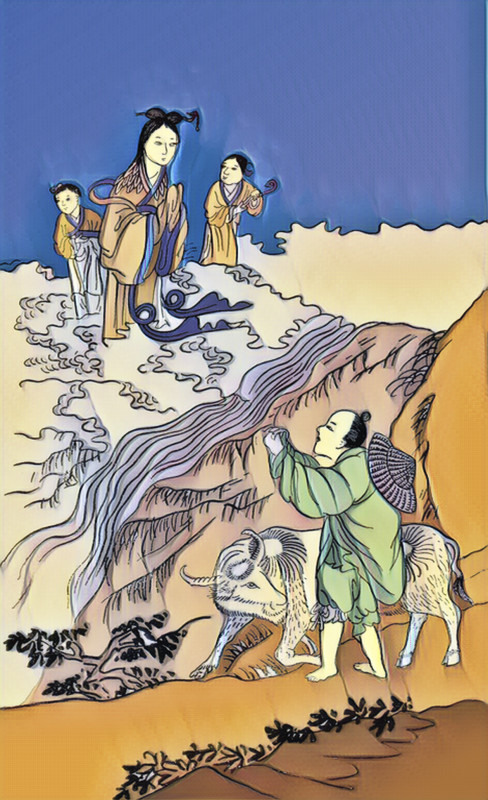
The ox has for centuries toiled in the fields of China. The same character Niu is used for oxen, water buffalo as well as cattle. The Emperor Hongwu founder of the Ming dynasty had humble origins and a picture of a boy riding an ox/water buffalo may represent him.
Because it is such a useful animal some Chinese will not eat beef, although this custom may come from the India because of the ban in both Hinduism and Buddhism. It is an animal of proverbial strength and water buffalo are often associated with rivers and water. Beef tea has for long been considered a potent medicinal tonic.
At New Year the Emperor himself dug a ritual furrow with an ox-driven plow. The ox is associated with spring (plowing), harvest and fertility and is one of the twelve animals of the zodiac.
Panther 豹 bào
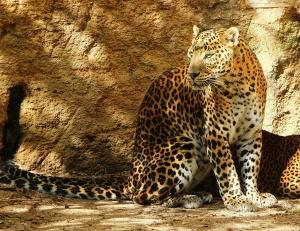
The panther (and the same character denotes a leopard as well) symbolizes the taming of cruelty. They were uncommon animals in China and do not feature much in paintings. If portrayed with a magpie (symbolizing joy), the panther can stand as a homophone for 报 bào meaning ‘announce, herald’ so together they give a wish for joy to come. A 花豹 huā bào is a term used for a headstrong woman. A depiction of a leopard was an emblem of one senior grade of Qing dynasty officials.
Pig 猪 zhū

The pig has long been domesticated in China. It is one of the twelve zodiac animals. It is a very widely eaten meat – except by the sizable Muslim population – so symbolically it represents feasting. A legend has it that the founder of the Khitan people of northern China had a pig's head and so the Khitan people would not eat pork. The ferocious wild boar 野猪 yě zhū used to live in the dense forests along the Yangzi and attack farmers and eat their crops.
The character for pig is used as part of the character for home 家 jiā, it show a pig under a roof, as the animals used to live with the family in rural homes. A superstition to protect new born babies was to give them pig's trotters for shoes and a pig's head mask so demons would think they were pigs, not humans, and so leave them alone.
Rabbit
See Hare.
Rat 大鼠 dà shǔ
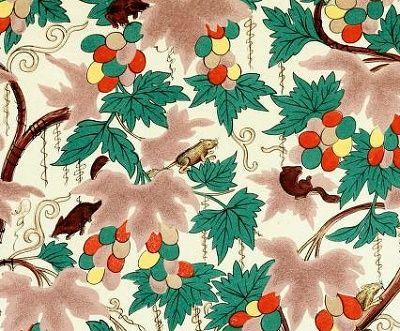
The rat is rather surprisingly the first in the cycle of twelve zodiacal animals, the story goes that a rat was smart enough to jump onto the back of the ox to get to the head of the queue of animals when they were being named. The character for rat 鼠 shǔ is a pictograph showing its head, tail and whiskers. The mouse is called 小鼠 xiǎo shǔ ‘little rat’ in contrast to 大鼠 dà shǔ ‘big rat’, the mouse plays little part in legends and superstitions. It is considered a ‘yin’ female animal.
The constant activity of rats has been paralleled with the acquisitive action of misers and so rats are associated with money. In one legend it was rats that brought rice to people's attention as a nutritious food. However it is also thought they can turn into demons and some legends have them becoming quails at spring time.
The squirrel (松鼠 sōng shǔ) uses the same character in Chinese, confirming the western nickname ‘tree rat’ and has the same symbolism. Rats and squirrels are often shown with trailing plants such as vines to give the wish for generations of children.
If rats move into your house it is a bad sign as cats will follow and it indicates the house will soon be derelict and abandoned. Not so long ago the local rat catcher would demonstrate his skill by laying out bundles of rat corpses on the street.
Rhinoceros 犀牛 xī niú
The rhinoceros 犀牛 xī niú has the name ‘sworded cow’ in Chinese. It has been nearly hunted to extinction. The herbivore is now restricted to a few localities just south of the Himalayas, Indonesia and central Africa. It could originally be found in Sichuan and then also in more recent years in Thailand and Vietnam. It has for two thousand years been hunted because its horn was considered the best antidote to poison and impotence. The horn is in fact modified hair and is made up of coarse filaments. Poachers still hunt wild rhinos because its horn fetches its weight in gold in Vietnam and China. Even antique rhino horn is sought after and ground down for use as ‘medicine’. Cups made of rhino horn were said to detect any poison in their contents and its hide was considered impervious to weapons. The immortal Cao Guojiu has a belt made of rhino hide.
In symbolism the rhinoceros was as an emblem for one grade of court official; it was also one of the eight precious things.
Scorpion 蝎子 xiē zi

Scorpions are one of the five noxious creatures 五毒 wǔ dú. There are 53 species of scorpion that live in many places throughout China. An ancient character used for scorpion is 万 wàn which now means ‘myriad, numerous, ten thousand’ that is the modern simplified form of 萬 and this is the form still used for the number 10,000 on bank notes. The association seems to be just that the characters sounded the same. 萬 is a simplified picture of a scorpion.
Sheep 羊 yáng
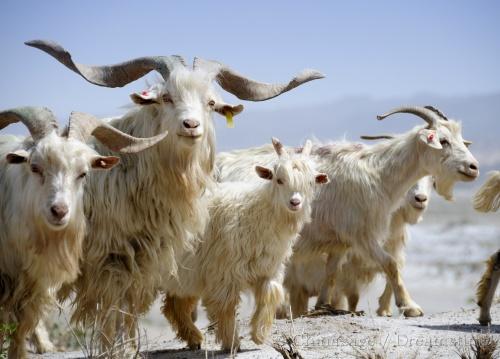
Sheep are one of the twelve animals of the Chinese zodiac. The character can represent either ‘sheep’ 绵羊 mián yáng or ‘goats’ 山羊 shān yáng. The sheep is a creature of northern rather than southern China although Guangzhou is known as the ‘City of Rams’ due to a legend about the populace receiving relief from famine by the kind intervention of magicians riding rams.
As it sounds the same as 阳 yáng it can be used to symbolize the male principle ‘yang’ and the sun. It also represents docility and satisfaction. The character is an ancient pictogram of the animal showing its horns and body as seen from above. Rather sadly the character for lamb 羔 gāo is the character for sheep held over a fire. Mutton is considered a strong source of yang energy. Combining the character for sheep and ‘large’ 大 dà gives a more kindly attribute - the character for ‘beautiful’ 美 měi.
Sheep symbolize respect for parents 孝 xiào because lambs kneel to take their mother’s milk. Three rams together represent the trigram which consists of three yang lines: 天 tiān heaven and the three months of spring. Lamb and mutton are commonly used by the Muslim Hui minority as a substitute for pork.
Snake 蛇 shé
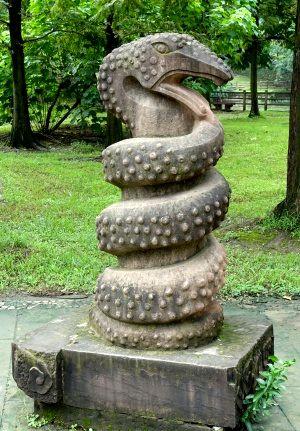
The character for a snake uses the radical for insect 虫 chóng followed by a pictogram of a cobra rising on its tail. It is one the five noxious creatures with centipede, gecko, scorpion and toad.
A snake is one of the twelve astrological year animals. Snakes are considered wise and cunning but treacherous. As a snake sloughs its skin it can symbolize transformation. It also symbolizes fertility and flexibility and the female yin element. The ancient deities Fuxi and Nuwa are often portrayed with snake-like lower halves. There are not that many venomous snakes in China, the few that remain are in Guangxi, Yunnan and Guangdong. There is a legend of the 白蛇 bái shé ‘White snake’ in Hangzhou that transformed into a woman who then married a man, a monk who then saw through her disguise and had her confined to a pagoda but not before a son was born who rose to become a great scholar.
The meat of the snake is eaten quite widely and it is a common ingredient in traditional medicine particularly snake liver. Snake meat is considered to be good for maintaining sharp eyesight and snakeskin is a popular lucky charm.
Spider 蜘蛛 zhī zhū

The spider is considered a lucky creature because it dangles from its web on high and so symbolizes good fortune descending from the heavens. Another auspicious connection comes from the name for spider 虫喜子 chóng xǐ zǐ because 喜 xǐ means ‘happiness, delight’. It may specifically signify a son returning home. On the negative side it sometimes takes the place of the scorpion in the tally of five noxious creatures.
Tiger 虎 hǔ
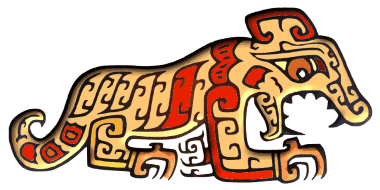
The tiger is the chief of wild animals and once was widespread in China. It proved useful as it kept down the population of wild boar that threatened crops. It is a zodiac animal and represents bravery. Rather strangely for such a fierce animal it is regarded as yin, particularly when shown together with a dragon that represents yang. The character ‘hu’ sounds the same as 护 hù meaning ‘protect’ and so a tiger is a powerful protective motif. The God of Wealth sometimes rides on the back of a black tiger.
Tiger suits were worn by soldiers to frighten the enemy. It was also considered to have the power to keep away demons – it was used in the First Opium War to keep back the British ‘foreign devils’. Tiger pictures are commonly pasted up on walls as a talisman during Chinese New Year. Because it is such a powerful animal many parts of the tiger are considered potent medicine and to this day tigers are hunted to supply the Chinese market for medicinal potions. As a tiger was supposedly never seen to limp, its bones are used as a ‘cure’ for arthritis. On its death a tiger's body was sometimes said to transform into orange amber. The White Tiger of the West 西方白虎 xī fāng bái hǔ is one the four divisions of the lunar month and day (mansions).
Toad 蛤蟆 há ma

The term 蛤蟆 há ma can apply to either frogs or toads. With rice paddy-fields so widespread in rural China, toads are a common sight as they love the wet habitat and prey on the many insects living there. It is one of the five noxious creatures with geckos, scorpions, snakes and centipedes. On the more positive side, the similar sounding 娃 wá is a term for a baby, so can symbolize a wish for children.
A toad is said to be the companion of 刘海 Liú Hǎi the god of wealth, and because of this association is often symbolizes a wish for riches. They are also known as 蟾 chán and in some regions this sounds the same as 钱 qián ‘money, coin’ and so this is another association of toads with riches. Some temples have large porcelain toads as money banks.
There is a legend that a three legged toad lives in the sun (others a raven or cockerel), although some say it is the moon (from earlier times). Zhang Guo Lao, one of Eight Immortals is sometimes depicted as riding on a toad.
Tortoise 龟 guī
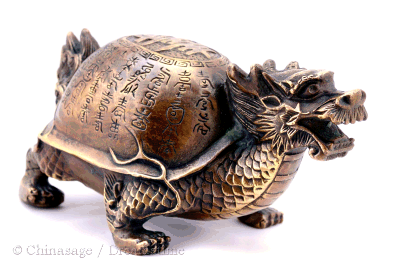
The humble tortoise is an important creature in Chinese mythology. For example, a giant turtle, the ‘Ao’ is tied up with creation legends. Both tortoises and turtles are named 龟 guī but the turtle is specifically called 海龟 hǎi guī ‘sea tortoise’. Tortoiseshell however comes from a Malay turtle and not tortoises. The traditional form of the character is 龜 showing a snake-like head with feet on the left side and tail below. The shape of its shell represents the earth - the flat ground below and the vaulted sky above.
The turtle is often used as a memorial, a stone turtle sculpture has an engraved tablet sticking up out of its back which lists the accomplishments of the deceased. These are called Bixi 赑屃 and form part of the sacred way to a tomb.
Many parts of the creature are used in traditional medicine, as it is such a well protected and long-lived creature. It is the chief representative of all shelled creatures and also one of the four sacred animals with the dragon, qilin, phoenix. In pictures it represents the wish for a long life and also solidarity. As it was never seen to mate it was considered that all tortoises were female. Some believed they mated with male snakes and from this comes the insult 王八 wáng bā 'tortoise egg' meaning bastard. The Black Tortoise of the North 北方玄武 is one of the four divisions of the lunar year and day representing winter and the north. In modern China however a toad can be used as a slang term for a cuckold.
A picture containing a round disk and a tortoise symbolize certainty of long life as 璧 bì ‘jade disk’ sounds the same as 必 bì ‘must’. The markings on its shell have long been puzzled over, some say the eight trigrams were inscribed on the back of a tortoise, and also that the magic square was marked out on the Lo Shu turtle.
It was considered an attendant to the creator of the world Pan Gu. Because they live for so long, they are considered to accumulate knowledge of the world and so turtle/tortoise shells were used in ‘oracle bone’ divination. Mention of tortoises for divination goes back to the Book of Documents - one of the most ancient Chinese classics. The pattern of cracks that emerge when a heated rod was placed against the shell gave the answer to the question that had been written on the shell. The shells give the earliest record of writing known anywhere in the world.
Unicorn 骐麟 qí lín
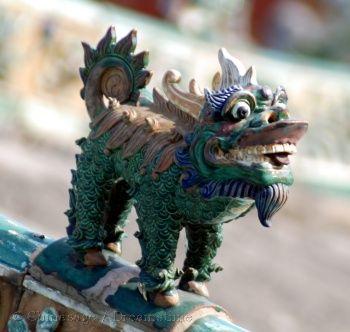
The Chinese unicorn shares some qualities with the western version but looks totally different: it usually has two horns and is covered in scales. It is a mythological animal that is peaceful and loving. Like the dragon it is such an important a creature we have a Qilin section describing it in detail. It is the representative of all furry creatures such as deer, horses and cattle. Its infrequent appearances are auspicious and in a picture it conveys good wishes and in particular a wish for many children.
Wolf 狼 láng

Wolves were fairly common in northern China so it is surprising that they did not acquire the rich symbolism and legends that animals such as the tiger, wild pigs and monkey have done. It is seen as a rapacious beast and, as in Europe, used to portray someone blinded by self interest and greed. Genghis Khan was reputed by the Chinese to be descended from a wolf. A wolf is considered to be a lecher and so a 色狼 sè láng is a ‘lecher’ or ‘pervert’.